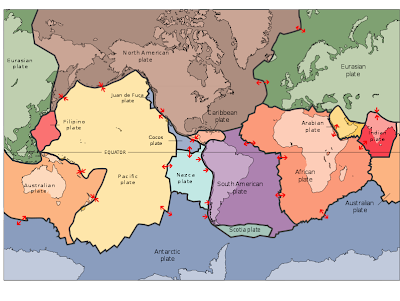Thinking about my out of balance tire wobble brought me to another subject that I have been reading about -- the Earth's wobble. Actually, there are several known wobbles in the Earth's rotations, and I am sure some of them are a direct result of the Moon pulling gravitationally on the Earth, planet alignments and the Sun. But that doesn't explain the motions of the 'Chandler Wobble'. On 18 July 2000, however, the Jet Propulsion Laboratory announced that "the principal cause of the Chandler wobble is fluctuating pressure on the bottom of the ocean, caused by temperature and salinity changes and wind-driven changes in the circulation of the oceans."-- I don't dispute their finding of facts, just their interpretation of those facts. Those facts could be the result of the Earth being out of balance.
When you observe the direction of drift of the Earth's plates, another conclusion may contribute to the findings of the Jet Propulsion Laboratories. What if the world is out of balance? Take a good look at the following drawing of the Earth's plates, the arrows indicate direction of drift, and follow my reasoning as you look at the drawing.
 Take notice that the two largest plates are the Eurasian plate and the North American plate. The North American plate seems to be rotating in the counter-clockwise direction. There is subduction on the Western and Southwestern side. The North American plate is in conflict with the Pacific and Eurasian plates. The Pacific plate appears to be in conflict with its Western counterparts with subduction occurring along the borders with the Australian, Filipino and North American plate. The Pacific plate appears to be traveling to the Northwest. The convergent edges are where one plate subducts the other back into the Earth's crust.
Take notice that the two largest plates are the Eurasian plate and the North American plate. The North American plate seems to be rotating in the counter-clockwise direction. There is subduction on the Western and Southwestern side. The North American plate is in conflict with the Pacific and Eurasian plates. The Pacific plate appears to be in conflict with its Western counterparts with subduction occurring along the borders with the Australian, Filipino and North American plate. The Pacific plate appears to be traveling to the Northwest. The convergent edges are where one plate subducts the other back into the Earth's crust.Now notice the Eastern edges of the Pacific and the Nazca plate. They move away from each other. The same holds true for the motions between the western side of the Eurasian and the Eastern side of the North American plates. Plates that are moving away from each other form a divergent border. As they spread apart, magma from within the mantle fills in the gap and spread the two plates apart. The small plates are probably sections that have broken off under the duress of plate motion.
My logic is that the crust of the divergent zones is thinner and is the weak sister of the tectonic world. The weakness of the thin crust enables the divergent zones and is the motivation for the plate movements that we observe. As the Earth spins on its axis, the major plates are energized to the point that they want to float on the Lithosphere a little higher, and in the process, the thin crust of the divergent zones are cracked enough to allow magma to erupt from the Lithosphere.
The best way I can illustrate the idea is to put a wad of chewing gum on a ball and spin the ball. The gum will certainly want to come of the ball, but while it is on the ball, the ball doesn't rotate evenly. (Wobbles) Not exact analogies but close enough for illustration of having so much of the worlds weight spread unevenly about the surface. Note also that the divergent edges are all in the Oceans where the crust is the thinnest. Take note of the notch carved out by the North Atlantic ridge through Iceland. Iceland has volcanoes, but is not thin crusted nor does the magma solidify as soon as it emerges and does not split apart at the same rate as the underwater sections.
The convergent zones and the divergent zones seem well distributed in both the northern and southern hemispheres. It looks like the Earth is trying to get the weight of the masses floating on its surface to balance. If we could live long enough, we might someday see the world spinning smoother with fewer Earthquakes and other tectonic phenomenon. It has probably balanced itself in the past, but collisions with Asteroids or other bodies--messed things up and changed the balance.
Caution! This article is only my musings. This is a stab at a logical interpretation of what may be true. Not a tested fact.
Cheers,
-Robert-
No comments:
Post a Comment
Please Include First Name and Town. -Thanks-